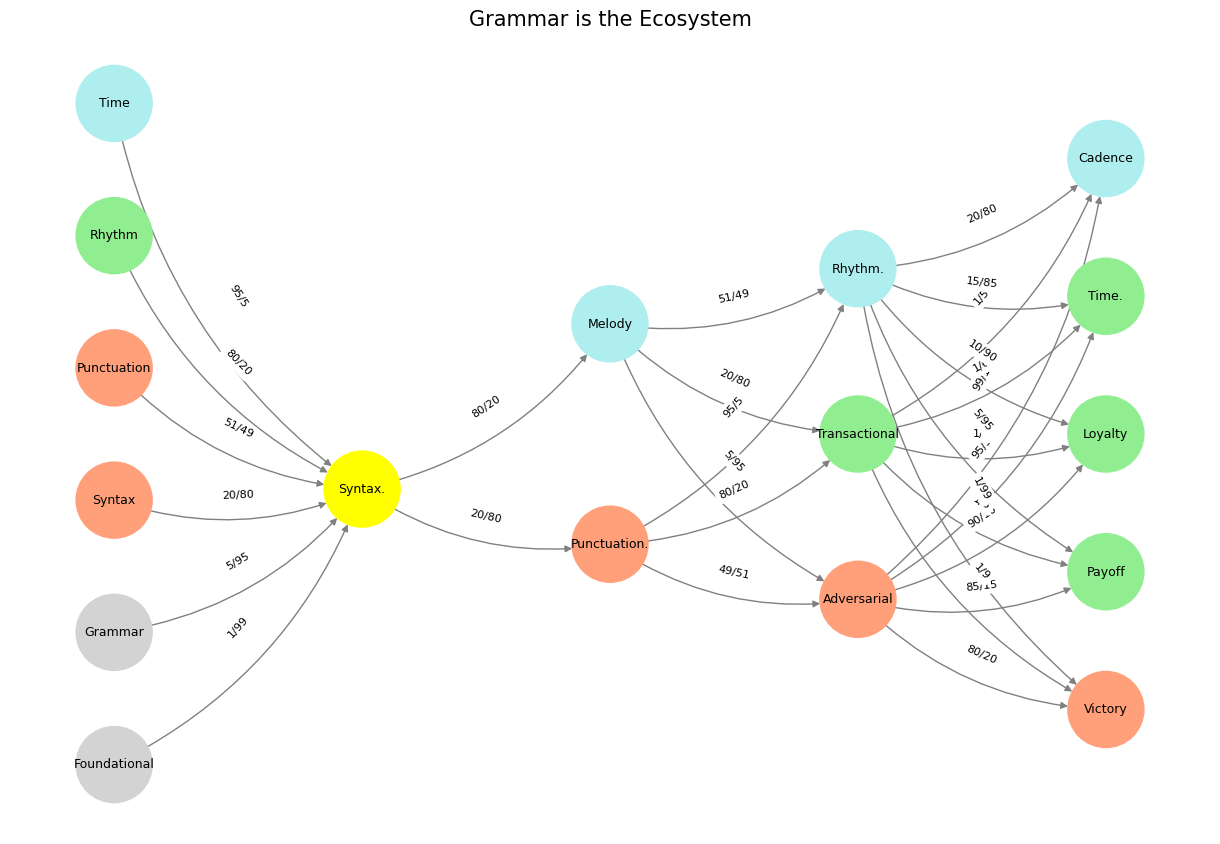Dancing in Chains#
Friedrich Nietzsche’s revisions to The Birth of Tragedy sixteen years after its initial publication were not merely a retreat from his youthful enthusiasm but a shift in emphasis—one that, in a deeper sense, still aligned with his original instincts. The second edition bore a new subtitle: Hellenism and Pessimism. In omitting Out of the Spirit of Music, Nietzsche seemed to distance himself from his earlier assertion that music was the generative force of tragedy. Yet in introducing Pessimism, he had not abandoned his initial insight so much as reframed it, moving from an overtly musical foundation to one that still engaged the rhythmic, temporal, and affective dimensions of language—precisely the domain governed by Brodmann’s Area 22 on the right hemisphere of the brain.
Pessimism, as Nietzsche understood it, was not merely a mood or disposition but a philosophical structure, an emergent property of how civilizations process and encode experience. Schopenhauer had argued that existence itself was suffering, that the world was driven by an insatiable, meaningless will, and that only through ascetic renunciation or aesthetic transcendence could one momentarily escape this relentless cycle. Nietzsche, at twenty-eight, had challenged this view, seeing in the Greeks not a passive submission to despair but an active embrace of tragedy as a way of affirming life in all its horror and sublimity. He had believed, at the time, that the fusion of Apollonian structure and Dionysian energy in Greek tragedy had allowed them to confront suffering without succumbing to nihilism. But by the time he wrote An Attempt at Self-Criticism, his stance had shifted. Hellenism and Pessimism implied not a reconciliation of suffering but an acknowledgment that Greek culture itself had, in the end, been unable to maintain the balance. The rational, orderly, Apollonian impulse had overtaken the Dionysian, suppressing the ecstatic element that had once given tragedy its force. Nietzsche’s later thought often frames this as the victory of Socratism, the rise of an intellectual tyranny that subordinates instinct and intoxication to abstract reasoning.
Yet in choosing Pessimism as his new conceptual frame, Nietzsche had not veered as far from his original insights as he might have believed. Pessimism, as a philosophical category, resides in the same cognitive terrain as music and prosody: it is temporal, affective, anticipatory. If optimism is structured by expectations of coherence and stability—an Apollonian desire for order—then pessimism is fundamentally a function of discontinuity, of sensing ruptures before they appear. It is, in essence, a prosodic stance, a mode of perceiving and interpreting the rhythm of existence rather than its formal structure. And if prosody is governed by Brodmann’s Area 22 on the right hemisphere, then Nietzsche, in shifting his title, had in fact reoriented his thinking in a way that remained neurologically consistent with his original vision. The movement from Out of the Spirit of Music to Hellenism and Pessimism is not a repudiation of the prosodic, Dionysian dimension of thought but an evolution toward a subtler and more profound engagement with it.
What Nietzsche may not have fully recognized is that pessimism, like music, is deeply intertwined with the human brain’s processing of time and uncertainty. Both involve the right hemisphere’s capacity for detecting shifts in pattern, for interpreting meaning not from static symbols but from the way those symbols unfold dynamically over time. The melancholic awareness of inevitable decline, of the instability of all things, is a function of the same cognitive processes that allow one to hear dissonance resolving into harmony or tension stretching toward release. In his early work, Nietzsche had treated music as the highest embodiment of this principle, seeing Wagner’s operas as the modern equivalent of tragic form. But in his later years, he came to regard pessimism itself as the more precise philosophical vehicle for expressing the same underlying reality.
Thus, Nietzsche’s instincts were correct even in their revision. The young Nietzsche, intoxicated by Wagner, saw tragedy as a musical phenomenon, a force that transcended the rigid structures of language and rationality. The older Nietzsche, having turned away from Wagner and deepened his engagement with philosophy, reframed his ideas in a way that replaced music with a more abstract prosodic sensibility—one that still functioned within the same cognitive and neurological framework. In shifting from Out of the Spirit of Music to Pessimism, he did not abandon the temporal and rhythmic dimensions of language and thought; he simply internalized them, translating them into the movement of historical consciousness itself.
This, then, is the lost opportunity—not that Nietzsche abandoned his early insights, but that he did not fully recognize how deeply they remained embedded in his later work. If he had explicitly acknowledged that pessimism is structured like music, that the collapse of civilizations and the dissolution of meaning follow patterns akin to harmonic modulation and prosodic inflection, he might have reached an even deeper synthesis between his early and later thought. Instead, the shift in subtitle appears as a rupture when, in fact, it was a continuation. The Nietzsche of The Birth of Tragedy and the Nietzsche of An Attempt at Self-Criticism are not in opposition, but in counterpoint—two voices in the same composition, playing out the unresolved tension between structure and dissolution, between Apollo and Dionysus, between grammar and prosody, between a world of order and a world that trembles at the edge of collapse.
Show code cell source
import numpy as np
import matplotlib.pyplot as plt
import networkx as nx
# Define the neural network layers
def define_layers():
return {
'Suis': ['Foundational', 'Grammar', 'Syntax', 'Punctuation', "Rhythm", 'Time'], # Static
'Voir': ['Syntax.'],
'Choisis': ['Punctuation.', 'Melody'],
'Deviens': ['Adversarial', 'Transactional', 'Rhythm.'],
"M'èléve": ['Victory', 'Payoff', 'Loyalty', 'Time.', 'Cadence']
}
# Assign colors to nodes
def assign_colors():
color_map = {
'yellow': ['Syntax.'],
'paleturquoise': ['Time', 'Melody', 'Rhythm.', 'Cadence'],
'lightgreen': ["Rhythm", 'Transactional', 'Payoff', 'Time.', 'Loyalty'],
'lightsalmon': ['Syntax', 'Punctuation', 'Punctuation.', 'Adversarial', 'Victory'],
}
return {node: color for color, nodes in color_map.items() for node in nodes}
# Define edge weights (hardcoded for editing)
def define_edges():
return {
('Foundational', 'Syntax.'): '1/99',
('Grammar', 'Syntax.'): '5/95',
('Syntax', 'Syntax.'): '20/80',
('Punctuation', 'Syntax.'): '51/49',
("Rhythm", 'Syntax.'): '80/20',
('Time', 'Syntax.'): '95/5',
('Syntax.', 'Punctuation.'): '20/80',
('Syntax.', 'Melody'): '80/20',
('Punctuation.', 'Adversarial'): '49/51',
('Punctuation.', 'Transactional'): '80/20',
('Punctuation.', 'Rhythm.'): '95/5',
('Melody', 'Adversarial'): '5/95',
('Melody', 'Transactional'): '20/80',
('Melody', 'Rhythm.'): '51/49',
('Adversarial', 'Victory'): '80/20',
('Adversarial', 'Payoff'): '85/15',
('Adversarial', 'Loyalty'): '90/10',
('Adversarial', 'Time.'): '95/5',
('Adversarial', 'Cadence'): '99/1',
('Transactional', 'Victory'): '1/9',
('Transactional', 'Payoff'): '1/8',
('Transactional', 'Loyalty'): '1/7',
('Transactional', 'Time.'): '1/6',
('Transactional', 'Cadence'): '1/5',
('Rhythm.', 'Victory'): '1/99',
('Rhythm.', 'Payoff'): '5/95',
('Rhythm.', 'Loyalty'): '10/90',
('Rhythm.', 'Time.'): '15/85',
('Rhythm.', 'Cadence'): '20/80'
}
# Calculate positions for nodes
def calculate_positions(layer, x_offset):
y_positions = np.linspace(-len(layer) / 2, len(layer) / 2, len(layer))
return [(x_offset, y) for y in y_positions]
# Create and visualize the neural network graph
def visualize_nn():
layers = define_layers()
colors = assign_colors()
edges = define_edges()
G = nx.DiGraph()
pos = {}
node_colors = []
# Add nodes and assign positions
for i, (layer_name, nodes) in enumerate(layers.items()):
positions = calculate_positions(nodes, x_offset=i * 2)
for node, position in zip(nodes, positions):
G.add_node(node, layer=layer_name)
pos[node] = position
node_colors.append(colors.get(node, 'lightgray'))
# Add edges with weights
for (source, target), weight in edges.items():
if source in G.nodes and target in G.nodes:
G.add_edge(source, target, weight=weight)
# Draw the graph
plt.figure(figsize=(12, 8))
edges_labels = {(u, v): d["weight"] for u, v, d in G.edges(data=True)}
nx.draw(
G, pos, with_labels=True, node_color=node_colors, edge_color='gray',
node_size=3000, font_size=9, connectionstyle="arc3,rad=0.2"
)
nx.draw_networkx_edge_labels(G, pos, edge_labels=edges_labels, font_size=8)
plt.title("Grammar is the Ecosystem", fontsize=15)
plt.show()
# Run the visualization
visualize_nn()


Fig. 28 G1-G3: Ganglia & N1-N5 Nuclei. These are cranial nerve, dorsal-root (G1 & G2); basal ganglia, thalamus, hypothalamus (N1, N2, N3); and brain stem and cerebelum (N4 & N5).#

